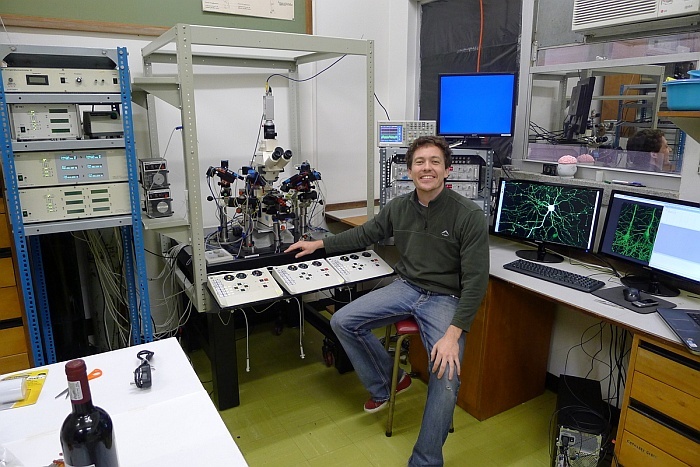Equipment helps researchers 'listen in' on brain's communication
02 August 2013 | Story Helen Swingler.
State-of-the-art patch clamping apparatus will soon allow researchers at UCT to 'listen in' on the brain's electrical communications. The apparatus was a gift from UCT alumnus (and world-leading neuroscientist) Professor Henry Markram to the Department of Human Biology, and it will grow basic neuroscience research in the health sciences faculty.
The patch-clamp technique won Erwin Neher and Bert Sakmann the Nobel Prize in Physiology and Medicine in 1991 and is a powerful and versatile technique for studying the electrophysiological properties of biological membranes. It's revolutionised research in cellular and molecular biology and in neuroscience it's allowing researchers to ramp up their understanding of the brain's circuitry.
New equipment, new research
Worth R1.5 million, the equipment is the first of its kind in the faculty, and possibly in any African institution, said human biology head Professor Lauriston Kellaway, in whose laboratory the apparatus has its home.
Markram is co-director of the Human Brain project and based at the École polytechnique fédérale de Lausanne (EPFL). Last year the BSc honours graduate from UCT (1985) landed the biggest funding award in the history of neuroscience - €1 billion (some R12 billion) granted by the European Union over 10 years. It will allow him to scale-up his work to simulate the entire human brain.
The cache he's donated consists of a sophisticated microscope and numerous high-precision robotic arms, which allow fine-tipped glass electrodes to be gently lowered onto multiple brain cells in a living slice of brain tissue, either rat brain tissue where the cells have been kept alive by perfusing the slice with an artificial brain solution, or from a patient who has undergone surgery for intractable epilepsy (to treat the epilepsy a small bit of the patient's brain is removed). This work is being planned with Professor Graham Feiggen in the Department of Neurosurgery.
Reading electrical currents
The job of installation fell to Dr Joseph Raimondo, a UCT alumnus with a doctorate from Oxford University. Raimondo is a specialist in the patch-clamp technique and worked with Markram in Switzerland before returning home to help build South African neuroscience research capacity.
It's a delicate business; the entire device is mounted on an air-cushioned floating table to prevent vibrations from interfering with the apparatus. Sensitive amplifiers enable computer-controlled readings to be made of the tiny electrical currents that form the basis of nerve impulses.
"The equipment provides direct access to four individual brain cells simultaneously, allowing researchers to 'listen in' on the electrical communication, which occurs within brain circuits," explained Raimondo. "It's this sort of activity between brain cells that forms the basis for thoughts and memories."
With this equipment UCT researchers can explore the cellular basis of these complex phenomena. It will also underpin their research into the mechanisms underlying debilitating brain diseases such as schizophrenia and epilepsy. The team will collaborate widely within UCT. An initial project, performed together with Professors Bob Millar, Arieh Katz and Feiggen, seeks to develop novel therapies for arresting epileptic seizures.
This is he research that keeps Raimondo busy, extending work he began at Oxford.
New generation of electrophysiologists
Kellaway and Raimondo will use this equipment to train a new generation of electrophysiologists who will help in the understanding and treatment of the numerous nervous system disorders, such as epilepsy, depression and schizophrenia, which affect South Africans.
It will also underpin Kellaway's efforts to establish the infrastructure for hosting future International Brain Research Organisation (IBRO) schools. Founded in 1961 IBRO is a global organisation that facilitates communication and collaboration among the world's brain researchers.
The new capacity gives impetus to the development of the currently proposed Clinical Neurosciences Institute, a translational institute that will span the basic and clinical domains in neurology, neuropsychology and neurophysiology.
The gift fulfils a promise Markram made to Kellaway, completing a circle begun in the mid-1980s when Kellaway and colleague Professor Rodney Douglas co- supervised Markram's BSc honours. It was this foundation that sparked Markram's interest in neuroscience and launched his career.
Kellaway and Raimondo are especially upbeat about possibilities around developing scientific capacity.
"Now we have the exciting prospect of local researchers being able to enhance South Africa's contribution to understanding our most enigmatic organ: the brain," said Raimondo.
 This work is licensed under a Creative Commons Attribution-NoDerivatives 4.0 International License.
This work is licensed under a Creative Commons Attribution-NoDerivatives 4.0 International License.
Please view the republishing articles page for more information.










